Garmin Vivoactive 3 Review: Initial Thoughts
Although I’ve had it a while, I’ve finally decided to write this Garmin Vivoactive 3 review. Okay, let’s see how this sports and fitness watch stacks up.
Before we move on, take a look at what we think are the best hiking watches of 2020.
I realised (after buying the Vivoactive…) that it’s only been two years since I last upgraded my running watch, which was itself the fourth Garmin running watch I’d owned. In some ways it’s hard to justify all the upgrades – my very first watch did pretty much what I need for most runs, in terms of providing me with distance, time, pace and a few other key metrics. None of that has really changed – it’s all the additional features that have kept me coming back for newer watches and, in this case, it’s the mix of a decent running watch with all-day lifestyle fitness tracking functionality (sleep, 24/7 heart rate, steps and more) that made this attractive.
I have to be honest, if you want a really thorough review of this watch, you couldn’t do much better than to read the DC Rainmaker one. It’s pretty hard to compete with DCR’s reviews, and I’m not going to try, but what I will do is talk a bit about the functionality and then more about how useful it actually is, what is it like to use in practice, and hopefully guide you towards some idea of whether it’s right for you.
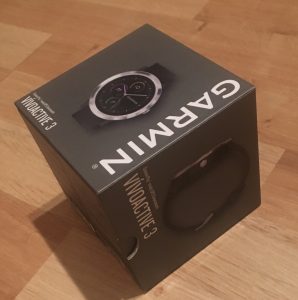
Visually, the watch is a move away from the chunky, very ‘smart-watch’ look of the previous Vivoactive, and a bit more towards the ‘watch’ look of the Fenix or some of the Forerunnner series. In its standard mode, it shows an ordinary analogue watch-face (with plenty of options available, including a digital watch in fact) and is fairly indistinguishable from an ordinary watch.
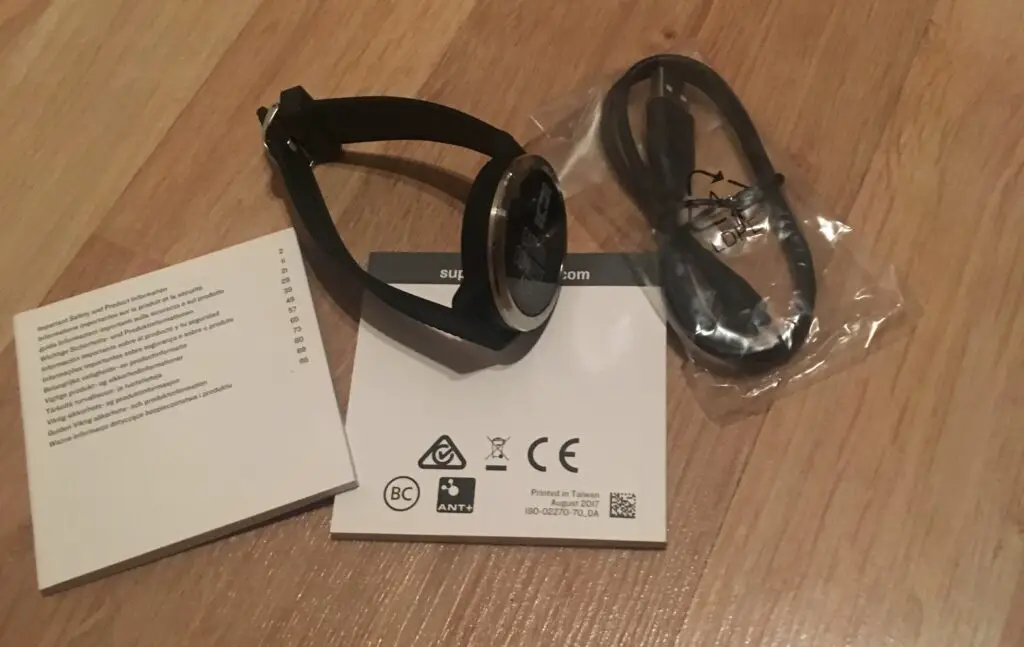
It comes boxed with just a manual/warranty info, and a charger. Nothing else, and no real need for anything else. As has been standard with Garmins and many other devices for at least a few years, the charger is a USB cable without a plug. I don’t have an issue with that, clearly they know that most people will have plenty of USB plugs lying around, or will charge through their computer anyway. The cable, incidentally, is the ‘standard’ Garmin charger that they have apparently finally released since I last bought a watch. All the previous ones I’ve owned have had unique charging cradles, which honestly is a pain in the neck.
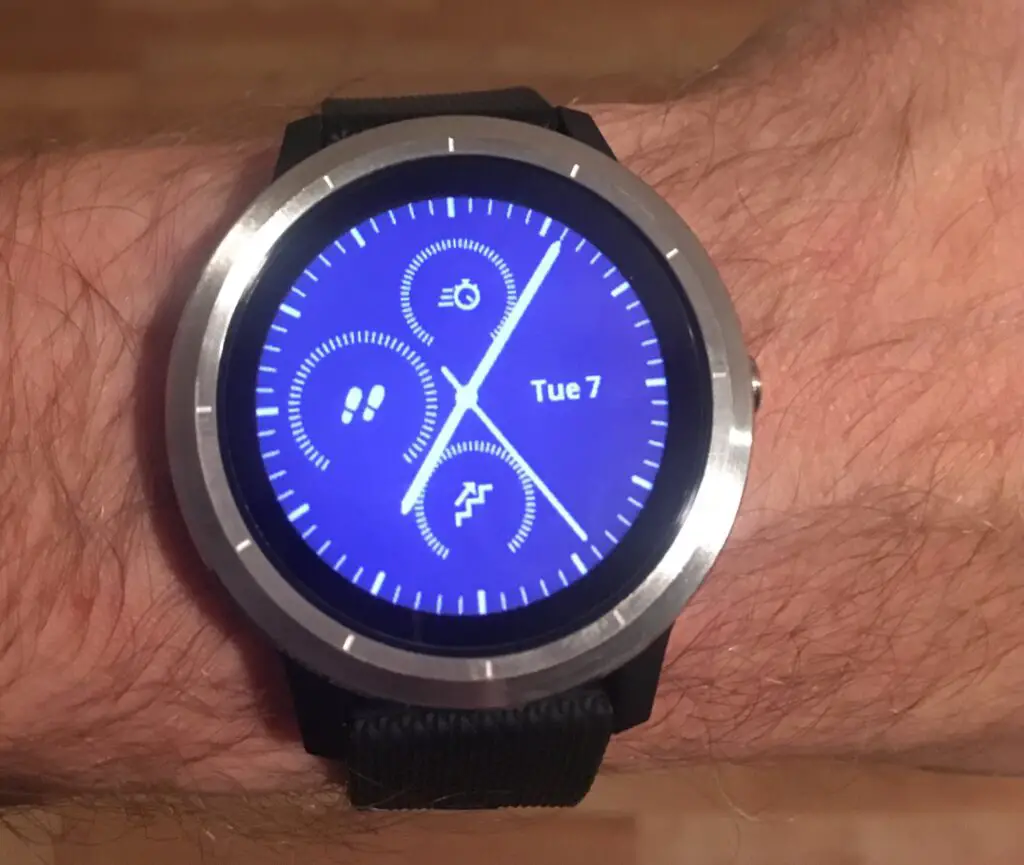
The watch is pretty sleek matte black with a silver bezel (other colours are available but this one seems to have been either the first to go out, or shipped in larger quantities, as it’s far more widely available) and a single button on the side. This button controls a lot of functions, including obvious ones like starting and stopping workouts, while navigating through menus is done primarily using the touch screen. There is also a touch-sensitive scroller on the side of the watch, which moves through screens and menu options. I found it a bit unpredictable and awkward to use, and much preferred just swiping through the touch-screen, but it may come down to personal choice.
Day-to-day use of the Vivoactive 3: Thoughts
For day-to-day use (i.e. not during a specific activity), it’s up to you what information you want to focus on. As well as the watch face, which can be customised and replaced with downloadable designs, the default set-up includes steps, ‘intensive minutes’ this week, heart rate info, flights of stairs climbed, notifications from your phone, weather, calendar, music controls, last activity details, and possibly a couple of other things I’ve forgotten. Personally there was too much info for me and too many screens that I didn’t need to see on the watch itself (since it is all viewable on the app) so I quickly trimmed this down to a slightly smaller number of screens, one of which is the ‘My Day’ which in any case summarises steps, flights, intensive minutes, and minutes of activity.
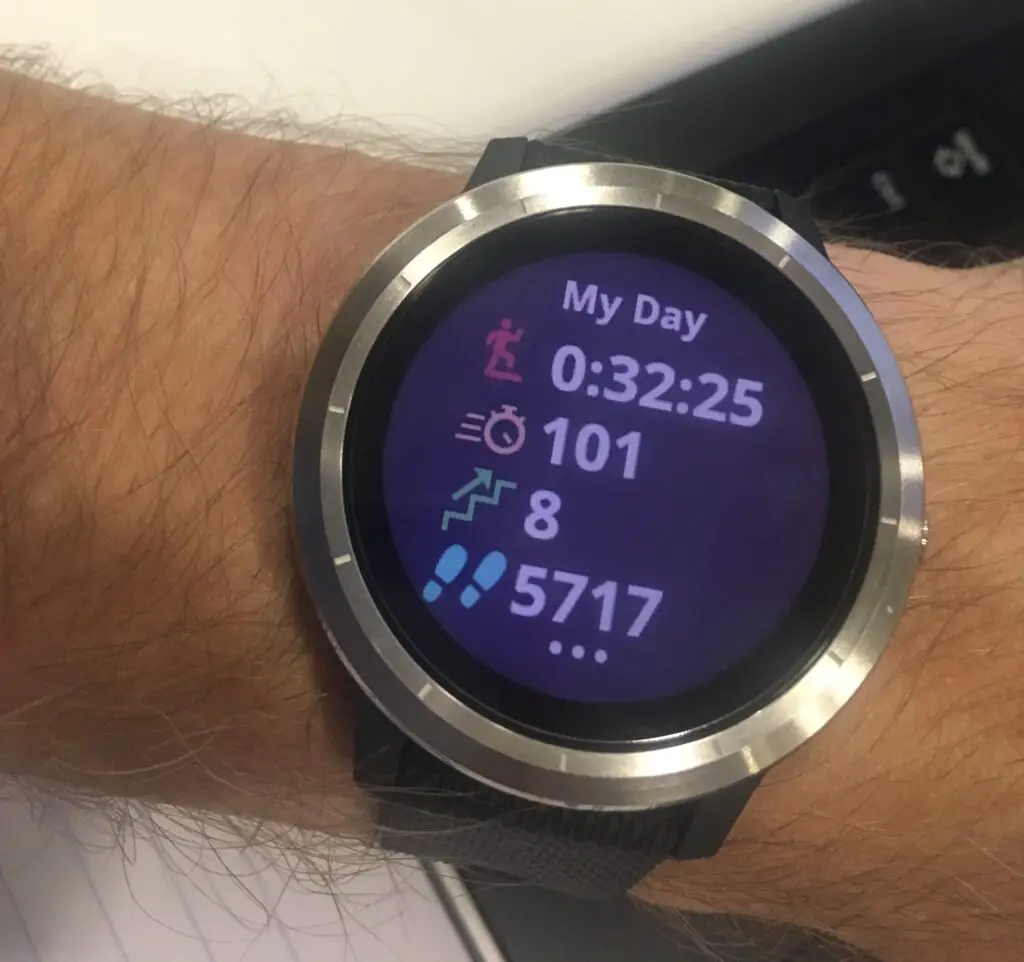
Whatever your preferences, it’s likely that the steps counter will be one of the key elements for everday use, as are the phone notifications. It’s the first time I’ve had a smart watch and I’m already loving having notifications sent to my watch, where it’s easier to quickly check them, especially if I’m in the middle of something else. During a run, of course, this is probably even more valuable, but I’ll come back to that.
I also kept calendar and weather, which are both fairly useful, heart rate, the full steps counter screen which includes goal and the red ‘inactivity’ bar, and the music controller. The watch doesn’t actually store any music itself, but it acts as a remote control for your phone. Day to day this probably isn’t a huge benefit, though it may be handy, but it will be brilliant when running, and for me is one of a few key justifications for upgrading from my Forerunner 225.
The watch also automatically tracks sleep, and that information is all viewable in the app, which is really the place to look in more detail at metrics (if you’re so inclined) such as sleep quality, stress score, average HR, VO2 max, and so on.
The ‘stress score’ is interesting, particularly as you build up more data and start to be able to recognise figures that indicate higher stress, or that you are becoming unwell. It’s linked to HR but it’s not as simple as a higher HR equals stress, so for example a day where you do a lot of walking shouldn’t necessarily register as a high stress day.
It’s also not just about emotional stress (though I think that would be partly reflected) but more about physiological stress and how ready your body is to train, based on a measurement of heart rate variability. I haven’t been using the watch long enough to have much data, but even in the week or so that I’ve had it, it was very noticeable that my stress score and average resting HR were both considerably higher on a day that I was extremely hungover.
Obviously I knew perfectly well that I would not be able to train at my usual intensity that day, so I didn’t need the data to tell me, but if I was feeling more subtly unwell; perhaps a bit rundown, or recovering from a two-week long illness and not sure if I was ready to get back into training, or how hard I should train while recovering, then being able to see this hard data could be really helpful.
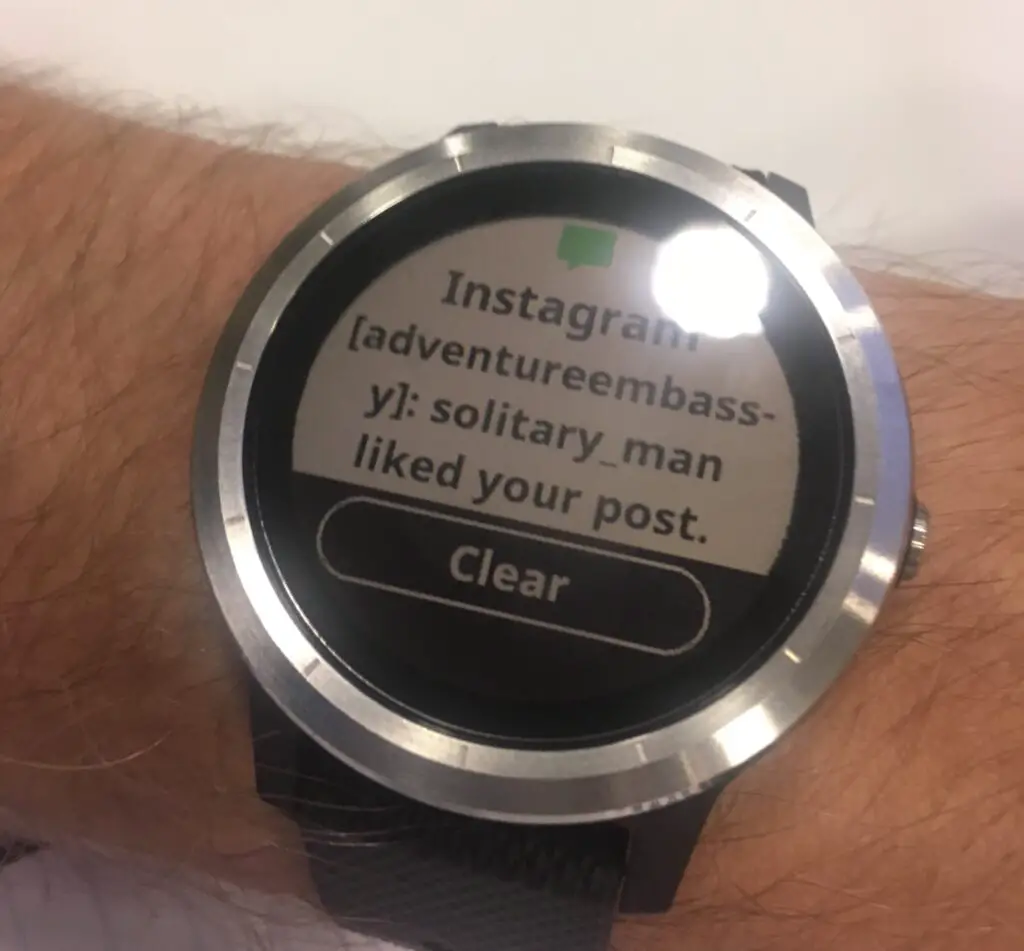
Another minor but nice feature is the alarm, which wakes you up by vibrating the watch – not a bad way to wake up, and especially useful if you wanted to wake up early (maybe for a run…) without waking your partner, or if you wanted to set an alarm while sleeping on a flight or a long train ride, or something.
So is it useful day-to-day? For me yes, absolutely. The phone connection alone justifies more than 50% of the price for me, and the 24/7 HR tracking, step counter, and sleep monitoring justify the rest, before you’ve even got to the activity features. I really like being able to slowly build up data about my health, sleep activity levels and so on, and then try to make small adjustments to improve it, and this watch is designed to do just that.
Running with the Vivoactive 3
The main sports use for this watch for me will be running of course. In this respect it works fairly similarly to most other Garmins I’ve had before. You can set up custom screens with between 1-4 fields each, on which can be displayed all sorts of information including speed, pace, distance, time, HR, lap averages, overall averages, and so on. It’s simply a case of choosing what information you are likely to want, and getting it adjusted.
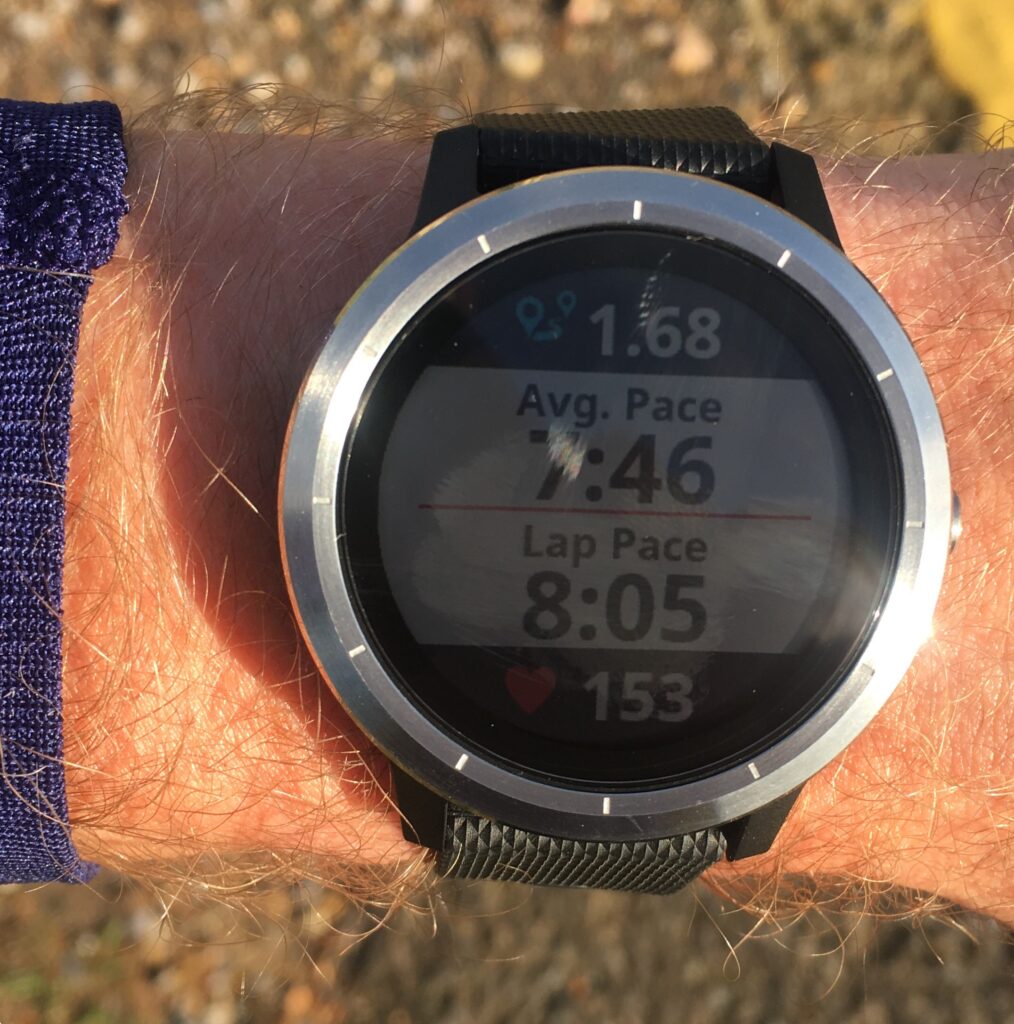
Other options from previous Garmins such as auto-lap and auto-pause still exist. Auto-lap at 1 mile is very useful if you want to easily see 1-mile averages as you run. Auto-pause is handy if you’re going to be stopping regularly at traffic lights, but it’s important to remember to turn it off before you race, or else any stop (for a loo break for example) will throw your data off for the rest of the event.
Heart rate continues to be tracked during runs, of course, and can be displayed with HR zones customised based on your age.
The big changes for me with this watch during runs are the notifications (you can disable these if you don’t want them while running, or set it to only display phone calls), and the ability to control music. Both are great for me while training – I like being able to quickly see messages and alerts as they come through, and I love finally having an easy way to skip songs when I’m running with headphones.
However… for a iPhone users there’s a frustrating caveat which is that the music control only works with Apple music, not with Spotify. In part this might be an issue with the iPhone which, unlike Android, doesn’t allow you to set a different default music player. However I’m not convinced that it’s not at least partly a Garmin issue – after all, other bluetooth devices such as headphones, give you pause, play and skip control over Spotify so I don’t fully understand why the Garmin Vivoactive can’t.
This isn’t the end of the world for me, but as a keen Spotify user it’s definitely an irritation. (Update: this is no longer the case and it works with Spotify. Hurrah)
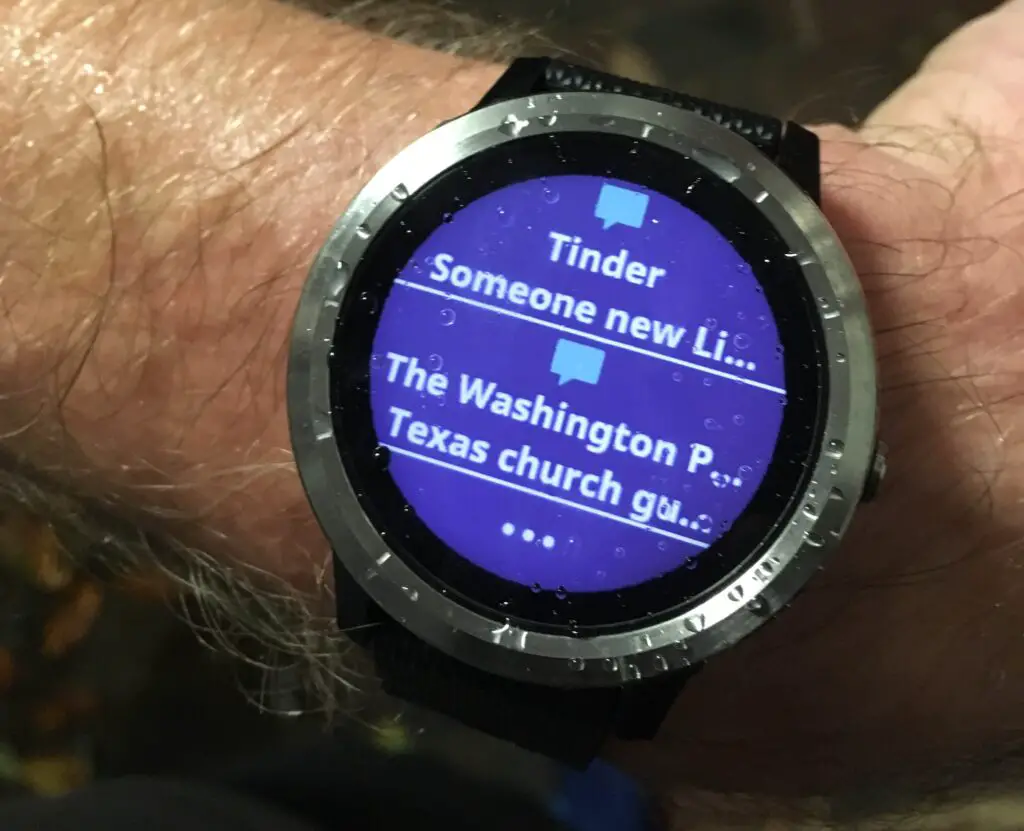
One change for me that is sort of a forward step and backward step is in custom activities. On the one hand, I really like the level of activity customisation possible on Garmin connect (phone or desktop). You can very quickly set up highly complex workouts, if you so choose, with all sorts of repeats and goals in them, and quickly sync them to your watch. It’s great. The only slight backwards step is that the 225 had an inbuilt ability to create and edit simple interval programmes. This isn’t possible within the Vivofit 3 – they would have to be done on your phone and then quickly synced over. That’s really not a massive problem, it’s much easier to create them on the phone anyway, but it’s a change to be aware of, especially if for whatever reason you don’t have access to your phone or a computer.
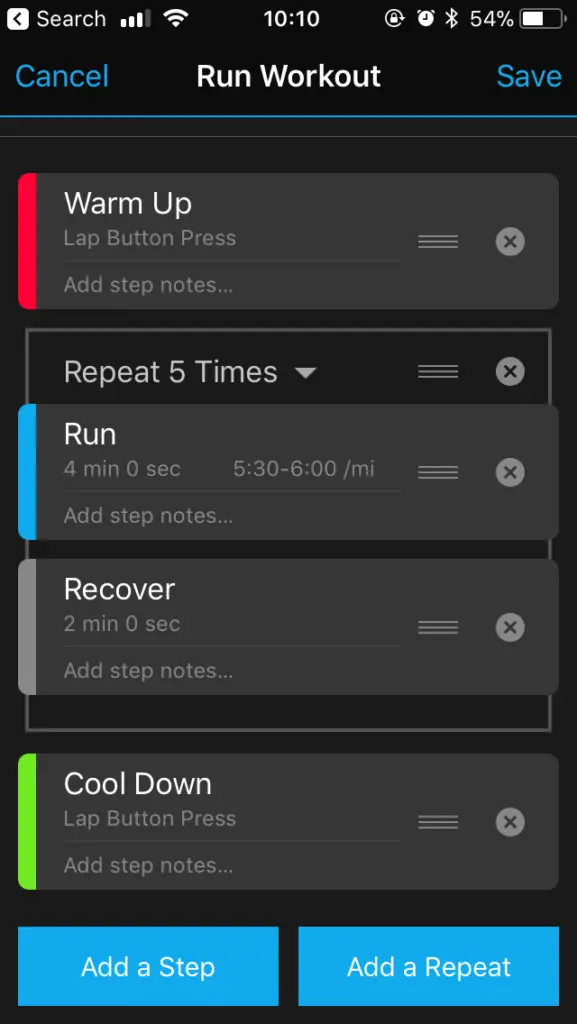
All the usual data is, of course, available at the end of the workout. Route, speed, pace, distance, HR, cadence (detected from the swing of the watch – a feature that’s been on watches for a while and replaces the foot pod that I used to have with my old Forerunner 610), altitude, weather, and so on. From your workouts, and presumably your HR though I could be wrong, Garmin Connect will also calculate and track your VO2 max, which is a new feature for me, and one that I’m interested in. It’s not directly useful day-by-day, but over time it should act as a relatively consistent measure of fitness regardless of what distance and pace of run I’m doing.
Other sports
One of the other reasons this watch appealed to me was that it caters for a wide range of other sports, including strength training and general cardio. In the past I’d tended to wear my 225 for these meaning that I could get the HR data, and then change them from a run to a workout later in Garmin Connect and Strava. It’s not a big deal, but it is nice to be able to record them in the right format to begin with. In addition, you can create workouts for these activities in the same way as a run, with various sets and reps, and the watch will then count reps and give you the chance to enter weight at the end of each set. I haven’t experimented with this hugely as most of my workouts are Crossfit style ones with too many varied movements for me to be bothered with this kind of tracking. All I want is a record of the workout length and HR data, so I just set it to a general cardio workout.
The other nice, and slightly amazing (in a ‘how technology has moved on’ kind of way) is that one of the many sports included is swimming, which tracks laps in an indoor pool. I used to have a whole separate device to do just this – my Garmin Swim which sadly I lost in a swimming pool changing room many years ago. Anyway, it’s not something I’d specifically spend money on (again) but it’s really nice to have. Just to be clear – this relies on you setting the pool length and then the watch detecting your turns and literally counting laps. It doesn’t use GPS and therefore won’t work for open water swimming.
I haven’t tried all of the other available sports, which include paddle-boarding and golf, and I’m probably not likely to. However I imagine that most incorporate some combination of logging HR, counting repetitive movements, and tracking distance travelled, depending on the nature of the activity.
Conclusion: Was it Worth Writing this Garmin Vivoactive 3 Review?
Definitely. No matter what gear we review, every care is taken to ensure we give you the best we can. Neither James, nor I, would recommend a piece of equipment that lacks merits.
Writing this Vivoactive 3 review was a pleasure. Overall I’m delighted with the watch. From a running point of view it does everything my 225 did, plus a bit more. Day-to-day it’s great to finally be tracking HR 24/7 so I can build up a picture of stress, health and fitness. And for both, it’s brilliant to finally have a smart-watch, that makes it easier to keep an eye on notifications whether I’m out on a run or in a meeting.




